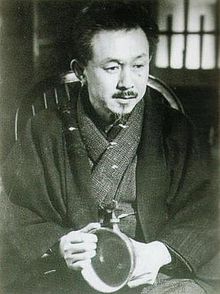Yanagi Muneyoshi
Yanagi Muneyoshi ( Japanese 柳 宗 悦 ; March 21, 1889 in Tokyo - May 3, 1961 ; in the West also read Yanagi Sōetsu with the same spelling ) was a Japanese art critic , religious philosopher and co-founder of the Japanese folk art movement. He was married to the singer Kaneko Yanagi , née Nakashima.
life and work
YANAGI was born in Tokyo as the son of the admiral of the Imperial Navy Yanagi Narayoshi . After graduating from the Gakushuin aristocratic school , he studied at the Tokyo University at the Faculty of Humanities and graduated in psychology in 1913. During his time at Gakushuin in 1910, he was an associate editor of the Shirakaba magazine . He later became interested in Korean folk art and the sculptures of Mokujiki Yōnin . He also studied and introduced the poems of William Blake and Walter Whitman .
Towards the end of the Taishō period, YANAGI occupied himself with folk art, for which he coined the term Mingei ( 民 芸 ). He conducted investigations and collected objects, gave lectures on them, traveled all over Japan and was also abroad. He associated with Shiga Naoya , Mushanokōji Saneatsu , Kawai Kanjirō , Hamada Shōji , Bernard Leach and others interested in literature and art. So a folk art movement developed, for which YANAGI published the magazines Kōgei ( 工 und) and "Mingei". - He taught philosophy of religion at Tōyō University .
In 1924, YANAGI succeeded in opening a museum for Korean folk art in Korea. In 1936, he established, supported a. a. by the entrepreneur Ōhara Magosaburō , a museum for folk art in the Komaba district, which made a great contribution to depicting the essence of folk art. His numerous publications include “Beauty in the Diversity of Vessels” ( 雑 器 の 美 , Zakki no bi ; 1926), “Folk Art in Japan” ( 日本 の 民 芸 , Nihon no mingei ; 1960), “Wesen der Kunst” ( 美の 法門 , Bi no hōmon ). - In 1957 he was honored for his work as a “ person with special cultural merits ”.
His oldest son was the industrial designer Yanagi Sōri , his second oldest son is the art historian Yanagi Munemoto ( 柳宗玄 ) and his third son was the garden architect Yanagi Munetami ( 柳宗民 ).
Remarks
- ↑ Later part of Gakushūin University .
- ↑ Ōhara was the founder of the Ōhara Art Museum in Kurashiki .
literature
- S. Noma (Ed.): Japan. An Illustrated Encyclopedia. Kodansha, 1993, ISBN 4-06-205938-X , pp. 318-349
- Suzuki, Toshihiko (ed.): Nihon daihyakka zensho (Denshibukku-han) , Shogakukan, 1996.
Web links
| personal data | |
|---|---|
| SURNAME | Yanagi, Muneyoshi |
| ALTERNATIVE NAMES | 柳宗悦 (Japanese) |
| BRIEF DESCRIPTION | Japanese philosopher and founder of the folk art movement |
| DATE OF BIRTH | March 21, 1889 |
| PLACE OF BIRTH | Tokyo |
| DATE OF DEATH | May 3, 1961 |
